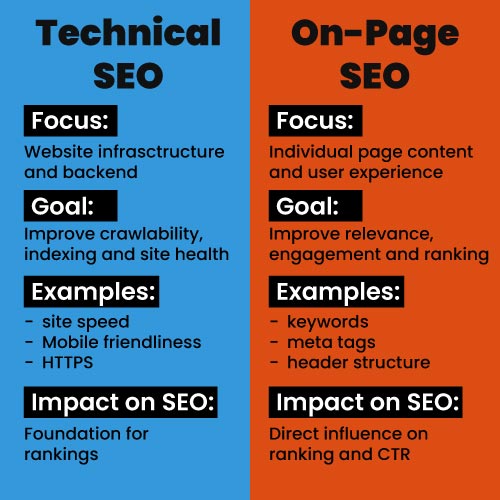In the ever-evolving world of digital marketing, SEO is the backbone of online visibility. But when it comes to optimizing a website, many people often confuse technical SEO with on-page SEO.
While both are essential for improving search engine rankings, they focus on different aspects of your website. Understanding the differences can help you implement more effective SEO strategies and boost your organic traffic.

What is SEO?
Search Engine Optimization (SEO) is the practice of enhancing a website to improve its visibility on search engine results pages (SERPs). SEO ensures that search engines can crawl, index, and understand your website while also improving the user experience. SEO is broadly divided into three categories:
- Technical SEO - Optimizing the technical aspects of a website.
- On-Page SEO - Optimizing individual pages to rank higher for specific keywords.
- Off-Page SEO - Improving a website’s authority through backlinks and external factors.
This article focuses on the first two categories: technical SEO vs on-page SEO.
What is Technical SEO?
Technical SEO refers to optimizing a website’s infrastructure so that search engines can crawl and index it efficiently. It doesn’t deal with content directly but ensures the site is technically sound, fast, secure, and accessible.
Key Components of Technical SEO
1.Website Speed and Performance
- Page load time is a ranking factor. Faster websites provide better user experiences and reduce bounce rates.
- Tools like Google PageSpeed Insights or GTmetrix help identify performance issues.
2.Crawlability and Indexability
- Ensuring that search engines can crawl your website efficiently is crucial.
- Use robots.txt, sitemaps, and noindex tags wisely to control what search engines index.
3.Mobile-Friendliness
- With mobile-first indexing, Google primarily uses the mobile version of your site for ranking.
- Responsive design and optimized mobile layouts are essential.
4.HTTPS and Security
- Websites must use SSL certificates to be secure. HTTPS is a ranking factor and builds user trust.
5.Structured Data (Schema Markup)
- Helps search engines understand content context.
- Enables rich snippets like reviews, events, and product details.
6.Canonicalization and Duplicate Content
- Prevents search engines from indexing duplicate pages by using canonical tags.
7.URL Structure and Site Architecture
- Clean, descriptive URLs improve crawl efficiency and user navigation.
- Proper internal linking enhances both SEO and UX.
Benefits of Technical SEO
- Improved crawlability and indexing by search engines.
- Faster load times, leading to better user experience and reduced bounce rates.
- Enhanced website security and mobile performance.
- Foundation for successful on-page and off-page SEO.
What is On-Page SEO?
On-page SEO focuses on optimizing individual web pages to rank higher for specific keywords and drive relevant traffic. Unlike technical SEO, on-page SEO deals primarily with content and its relevance to search intent.
Key Components of On-Page SEO
1.Keyword Optimization
- Conduct keyword research to target high-value search terms.
- Include keywords naturally in titles, headers, URLs, meta descriptions, and content.
2.Title Tags and Meta Descriptions
- Craft compelling, keyword-rich titles to improve CTR (click-through rate).
- Meta descriptions provide a brief summary for search engines and users.
3.Header Tags (H1, H2, H3)
- Structure content for readability and SEO.
- Helps search engines understand content hierarchy.
4.Content Quality and Relevance
- High-quality, informative content that satisfies user intent is crucial.
- Use multimedia like images, videos, and infographics to enhance engagement.
5.Internal Linking
- Connect related pages to distribute link equity and guide users through your site.
6.Image Optimization
- Use descriptive file names and alt tags for accessibility and SEO.
- Compress images to improve page load speed.
7.User Experience (UX) Factors
- Easy navigation, clear CTAs, and readable formatting enhance user engagement.
Benefits of On-Page SEO
- Increases relevance for target keywords.
- Improves CTR and engagement.
- Reduces bounce rates by satisfying user intent.
- Enhances content discoverability through proper internal linking.
Technical SEO vs On-Page SEO: Side-by-Side Comparison
| Feature | Technical SEO | On-Page SEO |
|---|---|---|
| Focus | Website infrastructure and backend | Individual page content and user experience |
| Goal | Improve crawlability, indexing, and site health | Improve relevance, engagement, and ranking |
| Examples | Site speed, mobile-friendliness, HTTPS | Keywords, meta tags, header structure |
| Impact on SEO | Foundation for rankings | Direct influence on ranking and CTR |
| Tools Used | Google Search Console, Screaming Frog, GTmetrix | SEMrush, Ahrefs, Yoast SEO, SurferSEO |
How Technical SEO and On-Page SEO Work Together
Technical SEO and on-page SEO are interdependent. Even the best content won’t rank if search engines can’t crawl your site. Likewise, a technically perfect website may not perform well if the content isn’t optimized for relevant keywords.
Example:
- Technical SEO ensures your pages load fast and are indexed.
- On-page SEO ensures those pages have optimized titles, headings, and content for users and search engines.
The combination creates a solid SEO foundation that improves rankings, visibility, and user engagement.
While technical SEO and on-page SEO target different aspects of a website, both are essential for effective SEO. Technical SEO forms the foundation, ensuring that your website is crawlable, fast, and secure, while on-page SEO fine-tunes individual pages to match search intent and relevance.
For a successful SEO strategy, it’s not about choosing one over the other — it’s about balancing both. Investing time in both ensures your website ranks well, attracts qualified traffic, and provides an excellent user experience.